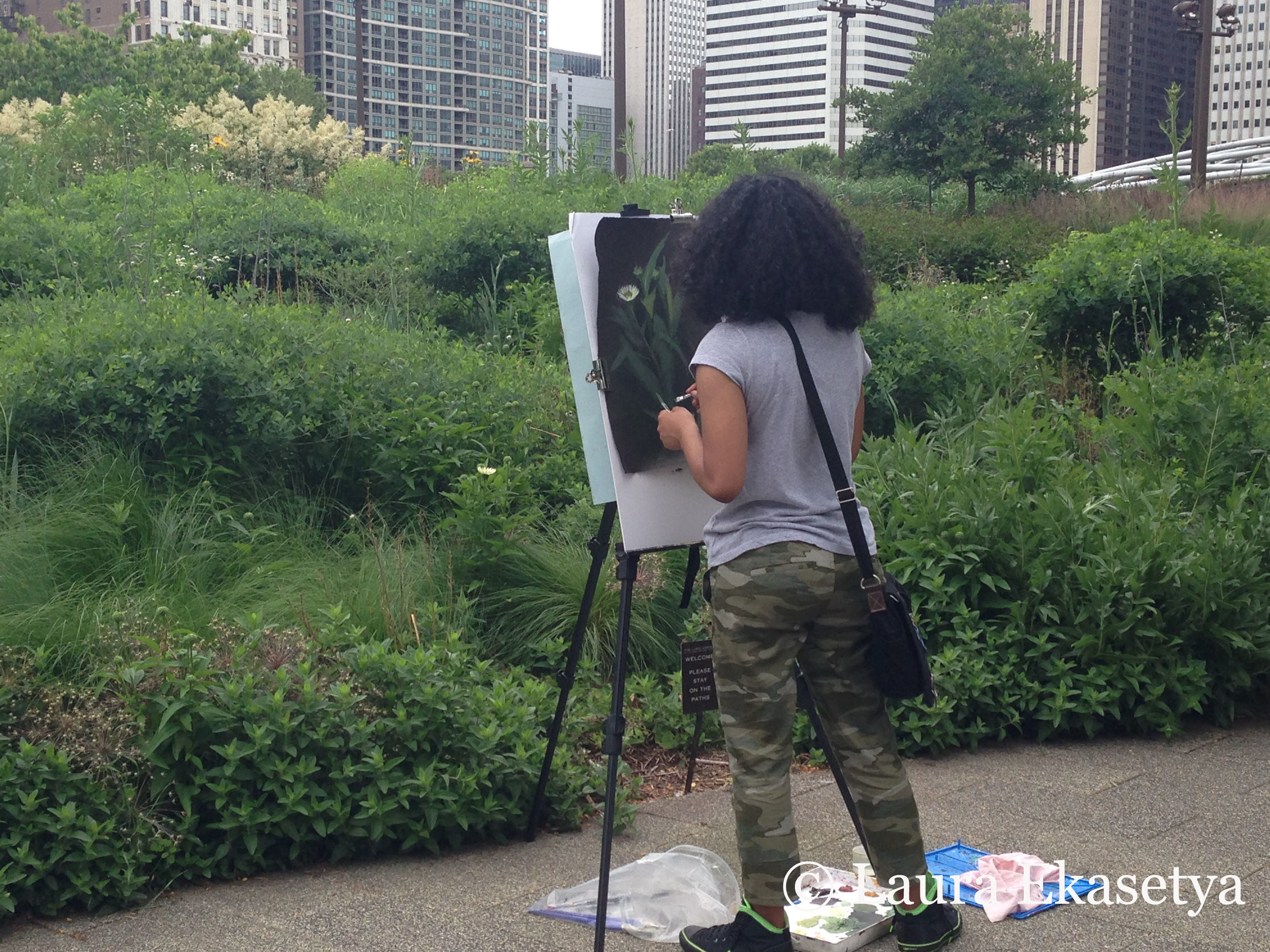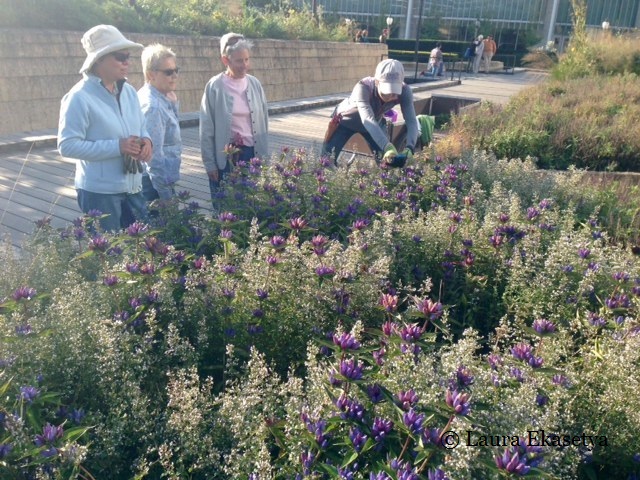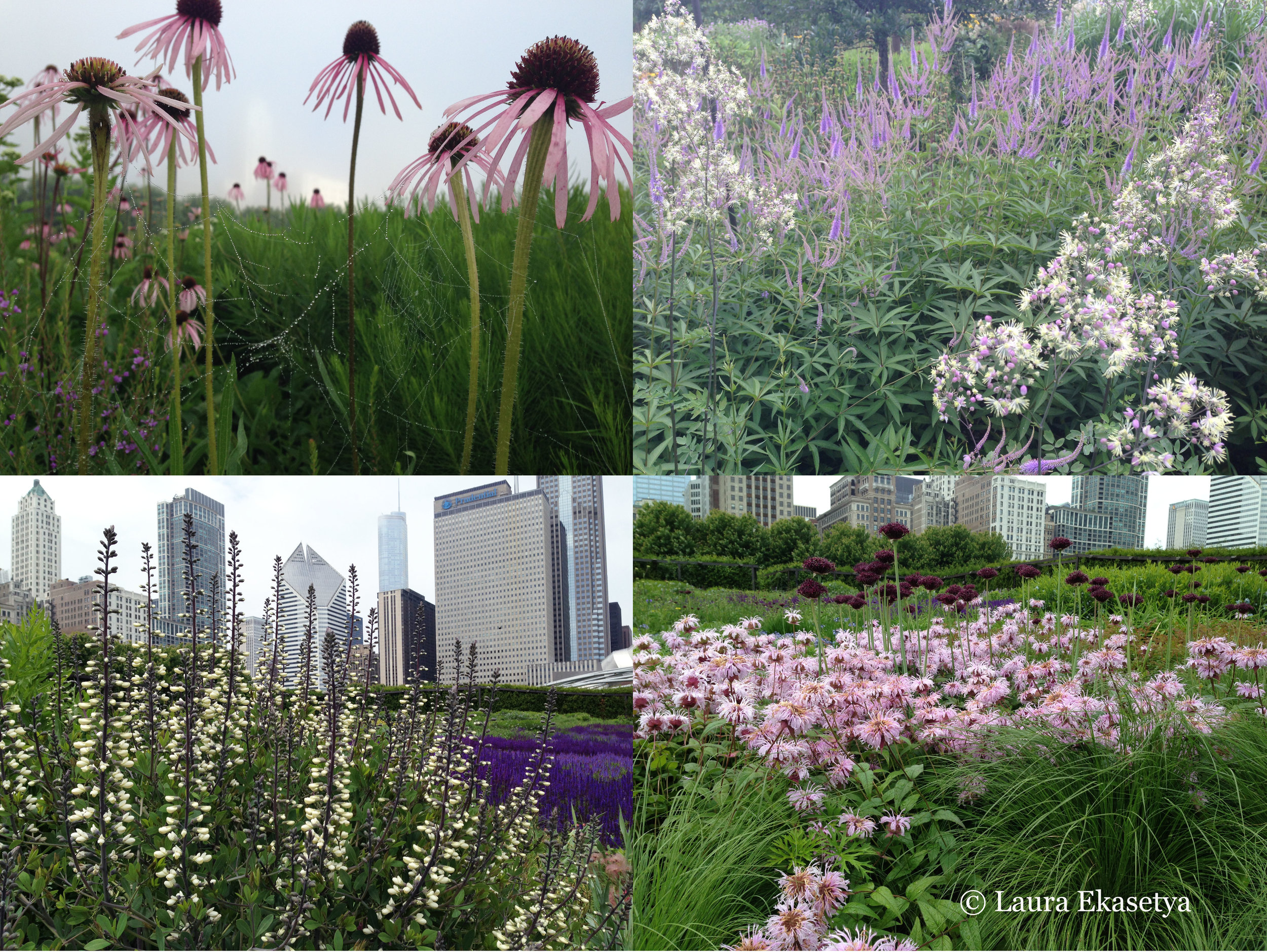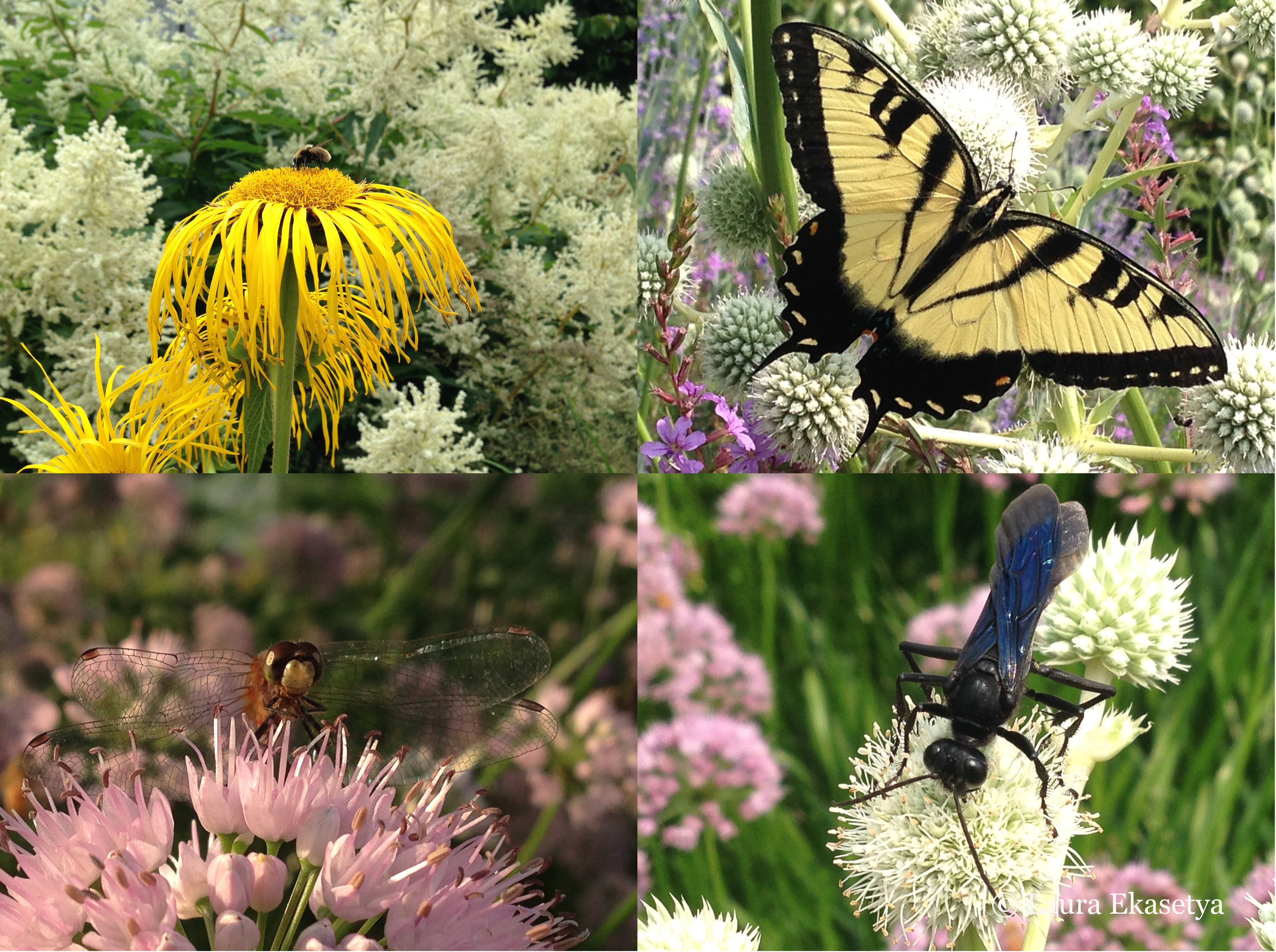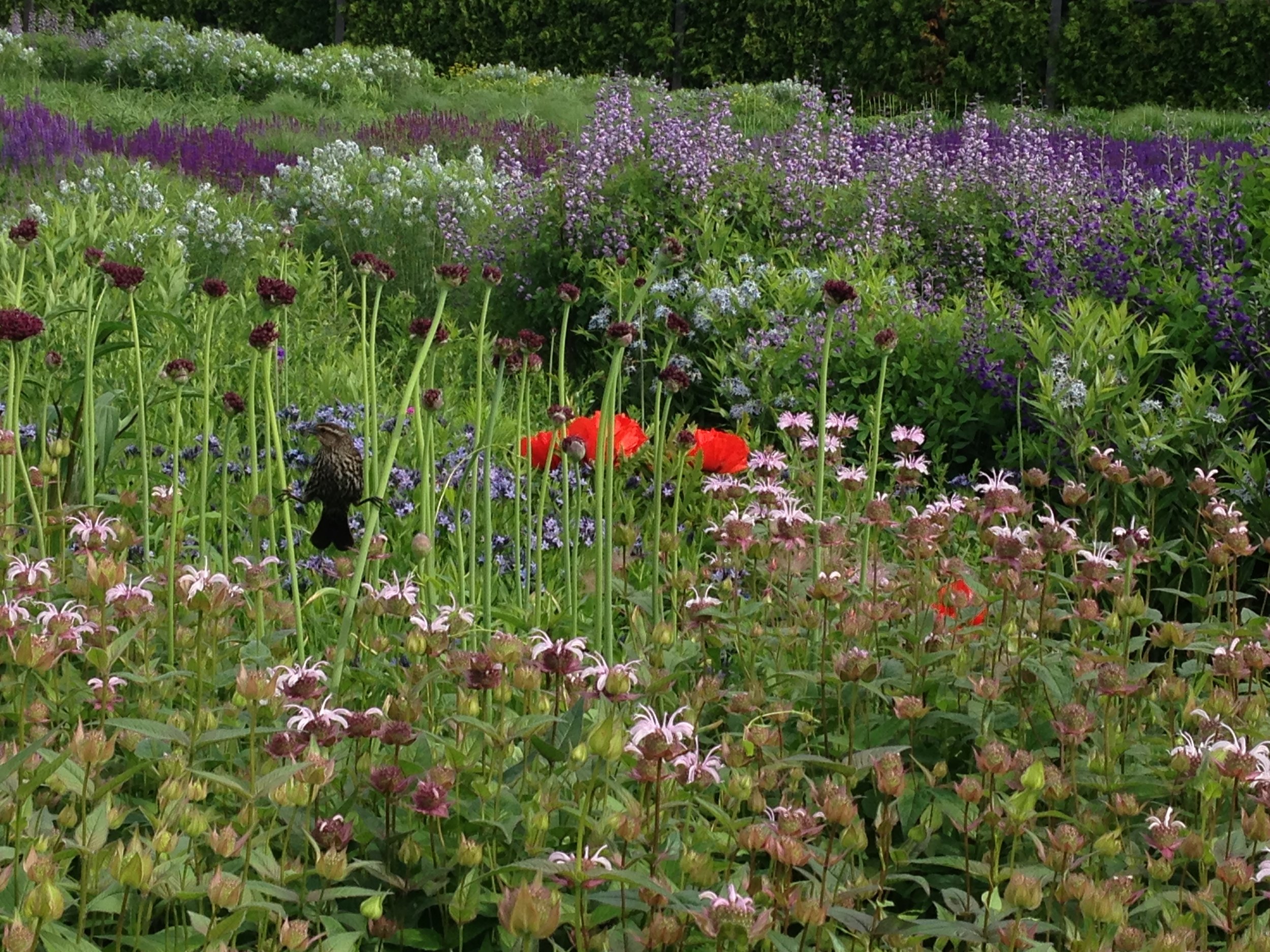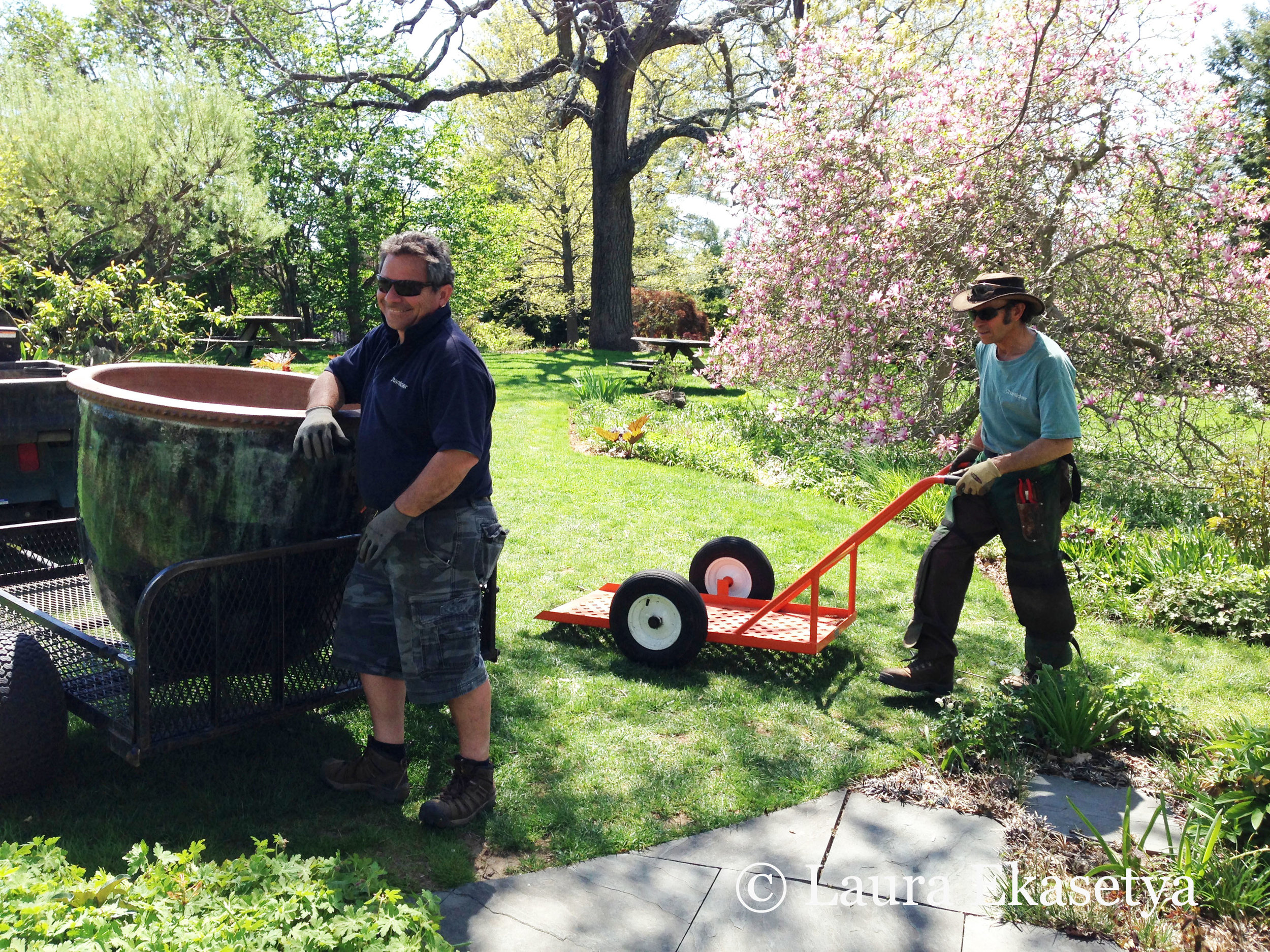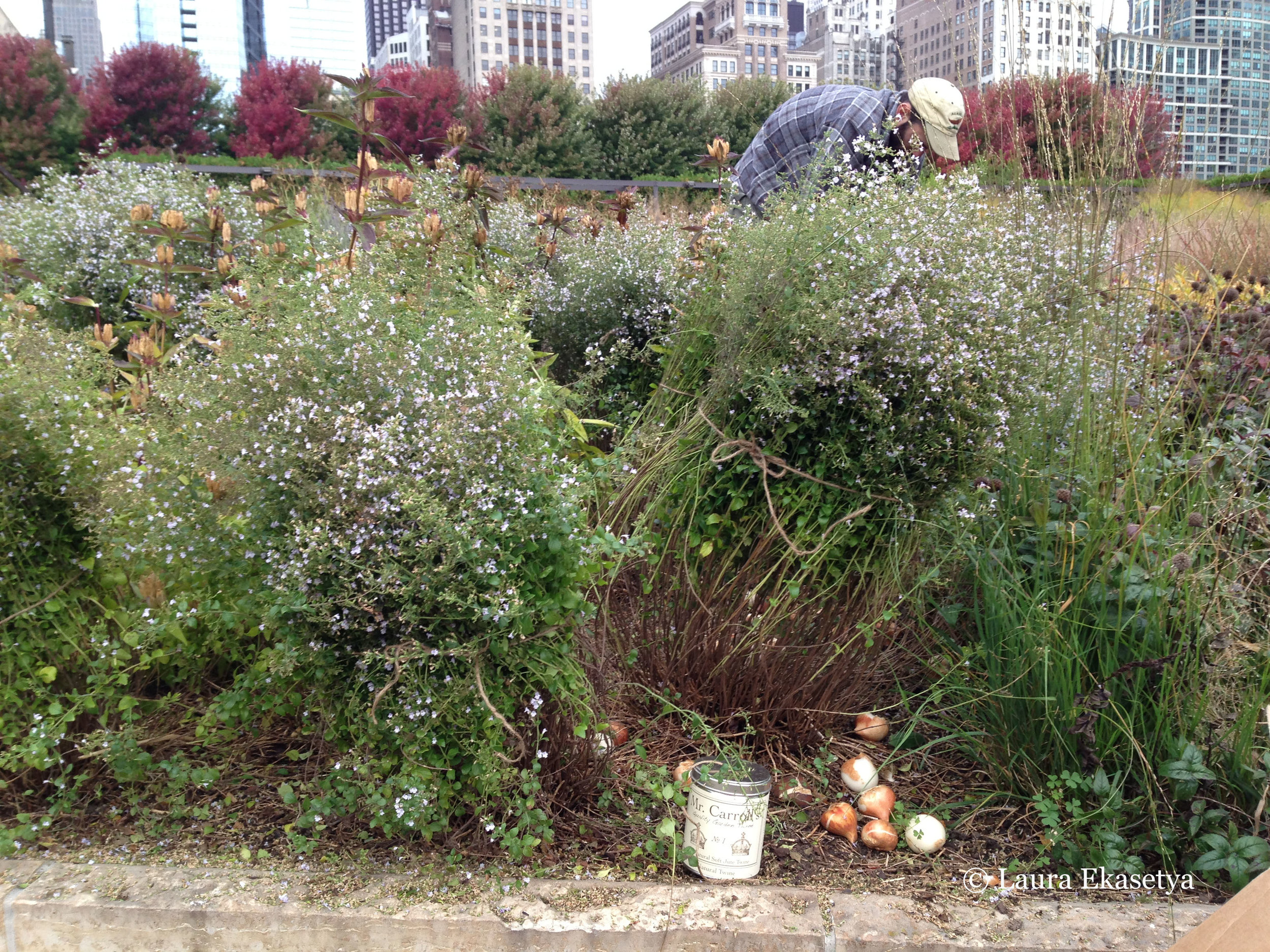5-10-5: Laura Ekasetya, Horticulturist, Lurie Garden
Laura Ekasetya was a week-long guest horticulturist at Chanticleer earlier this year, and I sensed in her an astute and inquisitive mind about plants and gardens. It is infrequent that we hear about the individuals who maintain the work of creative visionaries while keeping it afresh and evolving, and Laura is one of those fortunate souls who oversees the Lurie Garden in Millennium Park, Chicago, Illinois with her team of coworkers and volunteers. Coincidentally her colleague Jennifer Davit, the garden's Director and Head Horticulturist, was my classmate when I enrolled in the public garden management course at Cornell. She had nothing, but plaudits for Laura's work in tending the garden.
Please introduce yourself.
Laura Ekasetya, horticulturist at the Lurie Garden
The arts or the horticulture?
Horticulture and art are intertwined. Even though on a day to day basis I am not designing gardens, I'm maintaining the integrity of Piet Oudolf’s creative work, with plants providing the medium. I’m surrounded by the link between art and gardens every day. The modern wing of the Art Institute of Chicago overlooks the Lurie Garden. The garden’s topography was designed with that wing in mind, even though the expansion of the Art Institute was still in its planning stage at the time of the Lurie Garden installation. On a daily basis I am maintaining living art as a conservator would do, though the effect of time on a planting design is welcome. I recently read a gardening memoir "The Gardener of Versailles: My Life in the World's Grandest Garden" by Alain Baraton who has managed the over 2,000 acres of grounds including 230 acres of gardens at the Palace of Versailles since 1982. He writes that public horticulture is "an art de vivre--an art of living well and helping people to live well."
What does your job involve on a daily basis?
I spend much of my time working outside weeding and editing the planting design. I work with eight terrific hands-on volunteers who help out two days a week, and part-time with an intern. I also give tours and teach workshops as part of the Lurie Garden’s year-round environmental programming. I spend a good deal of time answering visitor questions. I update plant information on our website and record the bloom times of the plants in the garden as well as keep our Facebook page interesting. I assist with maintaining our two beehives. I do my best to record the variety of wildlife in the garden such as insects and migratory birds.
How did you become interested in plants and horticulture? What led to your current job at the Lurie Garden in the Millennium Park?
In early grade school my family lived for a few years in Midland, Michigan where I would ask my parents to take me to Dow Gardens, a lovely botanic garden, and the Chippewa Nature Center which has woodland trails to explore as well as a log cabin homestead with a vegetable garden. Seeing pink lady slipper orchids growing in their natural environment was really exciting to me. We moved to a rural area in central Illinois where I enjoyed gardening in the yard, but never realized that there could be career possibilities. I did a lot of farm field work every summer since age 11, so doing labor intensive work outside is something I'm very used to. I came to horticulture as a career choice post college after working a few uninspired years for clinical research trials at a medical school. I volunteered at the Chicago Park District where I learned about a horticulture degree program at a city college. I interned in the city’s forestry department for a year and then came to the Chicago Botanic Garden as a seasonal where I enjoyed working in the research evaluation gardens. After three years I came to the Lurie Garden. This is my 4th year at the garden.
Central Park in New York City has an Arcadian landscape idyll envisioned through Frederick Law Olmstead and Calvert Vaux who looked towards the pleasure parks and landscape gardens of Europe for inspiration. These greensward parks have become the imprimatur by which future parks were created. In contrast, the Millennium Park seems futuristic in fusing art, architecture, and landscape design Some people may argue that the 'smoke and mirrors' detract from a park's primary purpose as a place of tranquility and recreation, a green respite from the urban jungle. What are your thoughts about a traditional park versus a contemporary park that deploys entertainment venues and interactive art?
It does seem on the surface that fitting in all these recreational areas with a prominent music venue, a restaurant, and places for displaying art exhibits is a lot to ask of 24.5 acres, but great cities are all about maximizing what can be done with limited land. Much thought went in to planning the park in a way that its various components would work well together. The Lurie Garden is visually connected to the Frank Gehry designed Pritzker Pavilion, but the garden is also separated from the rest of the park by its 12 foot high Shoulder Hedge that surrounds the garden on two sides. When you look out at the garden facing the hedge, you see the skyscrapers towering above the park and then a lovely row of mature maples and then the hedge of Thuja which steps the garden down to human scale. This relative calm of the garden allows the visitor to observe the smaller things happening down at the level of the plants. Various pollinators and other wildlife become noticeable. It’s exciting to see the gleaming architectural work of modern man towering above the natural architecture of the plants which host the drama of insect life. They live among us largely unnoticed, though they were around long before humans, and our bodies will one day be consumed by these smaller lives. Taking in these two opposing worlds gives visitors a chance to step outside the routine drum of office life and experience something that refreshes the senses. It was always in the plan for Millennium Park to have an area specifically set aside for a garden. Eleven different landscape architect firms submitted plans for what was then called the “Monroe Garden.” Fortunately, Kathryn Gustafson (GGN Llc.) teamed up with Piet Oudolf to create the design that became the Lurie Garden. Their work really is what allows this contemporary park to also have a quiet side, though it is every bit as interactive as the other features of Millennium Park.
I visited Millennium Park several years ago during the American Public Garden Association's annual conference, and was fascinated by the dichotomy between the two art installations Anish Kapoor's Cloud Gate and Jaume Plensa's Crown Fountain and the Lurie Garden. It was fun to watch the public interact openly with these public art. Then you enter the Lurie Garden where the reactions were more 'hushed' and still enthusiastic about the lush plantings. What has been the public reaction towards the plantings in the Lurie Garden?
Though I wasn’t living in Chicago at the time, I did attend Millennium Park’s opening to the public in 2004. As the Grant Park Orchestra finished its performance for the evening, the Redmoon Theater company marched over Frank Gehry’s BP bridge bearing torches. The crowd from the concert spontaneously followed the parade of dancers to the Cloud Gate sculpture where a fire-themed performance was reflected into the mirrored “bean.” This performance fit well with the way the park encourages the visitors to physically interact with its features. People can go under and through Cloud Gate, even though it is a well regarded work of art. Fountains you are allowed to get into? Now that is an exciting concept. The Crown Fountain is full of families laughing and having a good time all the while literally immersed in fine art. The Lurie Garden has a water feature in the form of a stream that invites the visitors to dip toes in water on a warm day, a perhaps less jubilant activity than what goes on at the Crown Fountain, but one which encourages relaxation and taking in the surroundings peacefully. The way the paths of the garden move through the perennial plantings, you end up brushing against the plants. You really feel like you are in the middle of a meadow. The general visitor response at the time of the opening was a mixed one. The Seam feature has lovely lighting in the evening so that was easily appreciated early on, but to those not familiar with perennial gardens, they may have been underwhelmed at the size of the individual plants. It took about two years for the plants to grow to a size where the non-perennial plant savvy visitor could really “get” the garden’s design intent. Now when visitors see the garden for the first time they are amazed that such a vast expanse of planting exists right in downtown Chicago. The south entrance along the Seam has arborvitae on both sides for 70 feet or so and then opens up to the garden. A few years ago I was working near that part of the hedge when a child entering the garden shouted out, “This is Narnia!” There is a something similar to walking through C.S. Lewis’s wardrobe in entering Lurie Garden. It seems magically larger than its 5 acres somehow, and this is probably a result of the layered planting design having enough balance between complexity and coherence.
Piet Oudolf obviously cannot be at the helm of the Lurie Garden physically all the time, and somehow the Lurie Garden has to evolve without losing the Oudolf's signature touch. Oudolf himself has moved away from the drift-like sweeps of his earlier work at Pensthorpe and RHS Wisley towards looser, less definable matrix planting that mimics nature. Do you and your coworkers see a similar gradual development towards that style?
Piet has stayed involved with the garden since its inception, so yes I would say any change in his own style would have some effect on the garden today. We were fortunate to have him here this July to celebrate the 10 year anniversary of the Lurie Garden and Millennium Park. He suggested a number of small changes to the garden that largely involve adding new plant species and improving on existing plant combinations by adding even more variety to them. Possibly because of the High Line project in NYC where the plantings are more intermingled, some visiting garden design enthusiasts have wondered if we will keep the salvia river (a large drift of four varieties of salvia) as a feature in the garden. The Lurie Garden has a completely different scale than the High Line, which has narrow plantings. The salvia river works well both with the scale of the garden and with its tendency to be viewed from above by the Art Institute, by the surrounding sky scrapers, and even from the part-shade Dark Plate side of the garden which is topographically higher than our full-sun Light Plate. The salvia river is iconic to the Lurie Garden and to Chicago.
There is sometimes a mistaken belief that naturalistic gardens, especially those by Piet Oudolf, are relatively low or no maintenance, needing little human input. How do you cope with self-seeding plants or plants in the original design that failed to thrive?
Because the Lurie Garden is a chemical free garden, all removal of self-seeding plants and other weeds is done by hand. Our team of 8 gardening volunteers have been working with the garden for several years, so they are very knowledgable about the garden. We do thin some seedheads to minimize the number of seeds. Chasmanthium latifolium has beautiful spikelets that also, unfortunately drop a good number of seeds. Thinning the spikelets by half actually allows them more room to rustle in the breeze. Sometimes less is more! We do the same to Anemone hupehensis, Penstemon sp., and Scuttelaria incana. For our Amsonia species, we remove the seeds entirely. Though these pods are attractive in winter, we have other less prolific seeders that provide winter interest, so we can reduce maintenance while still keeping a winter garden. When plants do not perform as well as expected we replace them with something that will. We consult garden magazines and books, Piet Oudolf, and Roy Diblik to select something better. Often Roy will grow the plants for Lurie at Northwind Perennial Farm.
What are some of the challenges you and your co-workers face in maintaining a large public garden in an urban environment?
Most days, visitors are just happy to have a quiet place amid bustling downtown and are respectful of the garden and the staff. We have round-the-clock security including cameras in Millennium Park so that helps a lot with some of the strange things that are bound to happen in a free public park that is open from 6:00 am to 11:00 pm every day of the year. The park expects 5 million visitors this year. Fortunately, if a well-attended parade or concert dramatically increases foot traffic to the garden, we can temporarily close the garden and then re-open once the crowds have dispersed. Sometimes people try to pick a flower as they walk by, but most of our plants near the edges are really tough prairie plants such as coneflowers that can’t be easily picked. This bends the stems so I have to prune that type of damage in the morning, but really most people just stop and take photos and enjoy the garden in a way that causes no damage. People occasionally step in the beds to have their photo taken. Often they don't realize that this action can smash the plants and cause soil compaction, and they apologize after that is explained. We do have signs asking visitors to stay on the paths. We have great security that handle this issue well when staff are not around. Our garden is just as photogenic from the paths. We have this really observant security guard, Officer Barlow, who has been with the park since it opened. He is really great at his job and keeps a sharp eye on things.
The presence of wildlife in urban areas is always welcome. Have you see noticeable increase of wildlife taking advantage of the Lurie Garden during their migratory journeys?
The garden is just two blocks from Lake Michigan on the Mississippi flyway so migratory birds stop and rest in the Lurie Garden on their journey. We have plenty of insects and seeds for them. Many birders come to the garden during migration season. Since birds generally migrate at night, the morning and lunchtime are great times to see many different species of birds. We are a birding hotspot on Cornell's Lab of Ornithology citizen science website, ebird (http://ebird.org/ebird/hotspot/L2132400). Insects such as monarch butterflies lay their eggs in the garden, and twelve-spotted skimmer dragonflies are around in summer and migrate with the dragonfly swarms along the Great Lakes in fall.
What places and gardens inspire you?
The research evaluation gardens at the Chicago Botanic Garden always inspires. There’s a beautiful view of Oehme Van Sweden’s Evening Island garden from the Lavin Sun Evaluation garden. Seeing all different cultivars growing right next to each other is really interesting. Many of the plants are part of Jim Ault’s breeding program, and it’s fun to see what is happening there. I often consult Richard Hawke’s evaluation notes on the CBG website.
Possibility Place Nursery, run by Connor Shaw and his sons, is an adventure. They propagate most of their stock from wild-collected seed, so it's great to associate with people who have a lot of patience and passion for regionally native plants.
Northwind Perennial Farm in Burlington, WI is inspiring as well as charming.
Gardens by the Bay in Singapore has got to be the world's most over-the-top horticultural project. Keeping glass houses cool takes more energy than the other way around and yet these two stunning 2.5 acre conservatories are carbon positive! This place is a joyous theme park for plants.
I had the opportunity to work as a guest gardener at Chanticleer for a week last May. That was a very inspiring experience for me. The staff there have such thoughtful visions for the areas they manage. I learned a lot from envisioning the different garden areas through the perspective of each person I worked with. The variety of plants at Chanticleer was thrilling.
The Europeans have always appreciated our Midwest flora that the garden writer Allen Lacy often joked about our plants going aboard for an European education before we American gardeners accept them in our 'beds'. Only in the last ten or so years have we seen reinvigorated breeding programs in Baptisia, Coreopsis, and Echinacea on our shores. What are some of the North American prairie perennials or woody plants you feel are overlooked or underused? Some may be good candidates for breeding.
Pycnanthemum muticum is such a fantastic pollinator attractant that I can't imagine having a garden without it. It doesn't take over as readily as other mountain mints, and its mossy-green color is uncommon. This plant requires a bench in front of it so that the insect variety can be fully appreciated. I also love Euonymus atropurpureus for its color and showy fruit; it looks like a valentine. This shrub could be a good candidate for breeding for compact habit. An underused tree in the landscape is Carya illinoinensis. For areas in need of large shade trees, it really produces prodigious quantities of fantastic pecans (you will need two trees). Though more popular as a crop in the south, the pecans from this Illinois native and its cultivars have a higher oil content and superior flavor.
We are trying out Euphorbia corollata in the garden next spring. I'm really excited to see how this native beauty will fit in with the Light Plate plantings.
What is your desert island plant?
A durian tree. If I'm alone on a desert island there will be no one to complain about the smell.
What is your advice for those seeking a career in public horticulture?
Find mentors in the field, and if you can't go work for them offer to help them out with something. Learn everything you can from those who have made horticulture their life's work. I'm fortunate to have a boss who demonstrates amazing leadership and organizational skills. Your career will develop much more quickly if you work hard for people who have ability and are patient and confident enough to share that with others.
What do you look forward the most in the future?
Several years ago at the Chicago Botanic Garden I was planting some evaluation plots with Jim Ault and a group of volunteers. These two older ladies, who turned out to be sisters and in their late 80's and mid 90's, were barely holding each other up as they hobbled along the beds. They asked about this nearby plant and Jim told them it was a phlox he bred that he intended to put on the market but that it wouldn't be available for a few years. They said they looked forward to having it in their gardens. I love the optimism there. Gardeners get a reputation for being grumpy, but really we are the most optimistic people around. That's what I look forward to, a lifetime of looking forward to the next plant.
Thank you Laura!
~Eric




